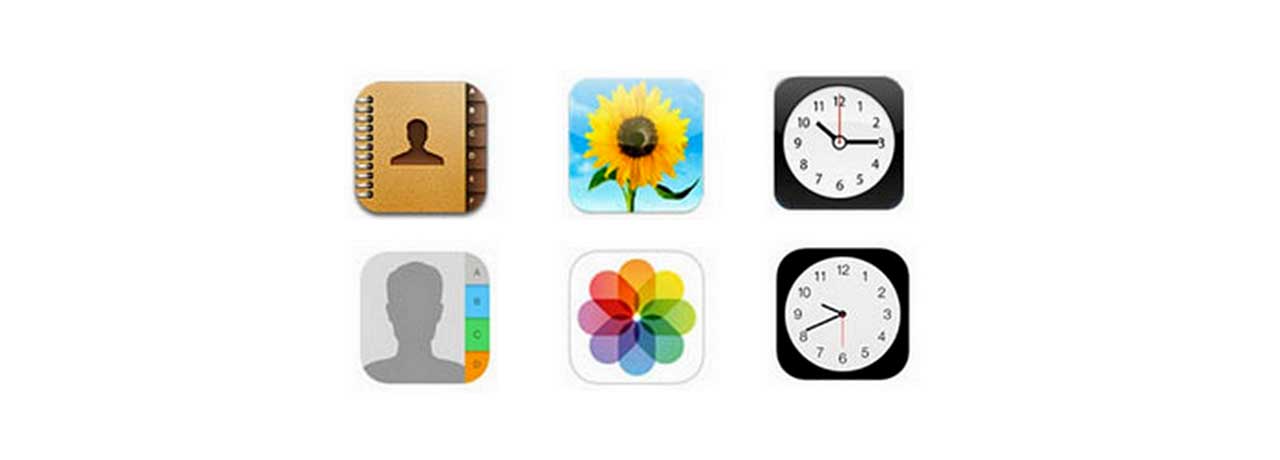-
-
-
-
URL copied!
Gone are the days when designers used flashy illustration, animation, and ornamental elements to wow the user. Even though skeumorphism (i.e., creating 3D effects on a 2D surface) was very popular just a few years ago, designers now risk dating their websites or apps by using it.
Up until 2012, skeumorphism was the leading trend in digital design. Based on the Greek words “skeuos” (i.e., container or tool) and “morph” (i.e., shape), skeumorphism design took its cues from the physical world. Its primary focus was to make icons and other UI elements look “real.” Designers had to keep light and shadow in mind to prevent objects from looking fake.
Skeumorphism was one of Apple’s key design principles. Steve Jobs was able to successfully bridge the gap between new technology and non-techie users by providing elements that looked familiar, such as a 3D address book icon on the iPhone to represent a user’s Contacts list. This contextual approach enabled users of all levels to comfortably transition from the real world to the digital world.
However, digital interfaces are common now. Users don’t need UI elements to look like real world objects to understand them. Goodbye to complicated designs that are dominated by brushes, gradient drop shadow, strokes, light effects, etc. Now designers are creating UI elements with simple flat shapes and icons.
Microsoft and Apple have made this design popular during the last few years. Microsoft used flat design in Windows 8, and Apple also ditched skeuomorphism in iOS7. Below you can see a side-by-side comparison of Apple's iOS6 icons (skeumorphism) and iOS7 ions (flat design). The Contacts and Photos icons have become more symbolic, and the Clock has been stripped of its lighting gradient.

Below are the five principles of flat design and notes on how to achieve these goals:
-
Remove depth: Remove 3D elements from the UI, drop the depth, and remove all shadows, gradients, and strokes.
-
Use simple elements: “Flatten” icons and other elements by using simple shapes; ornamental elements are unnecessary clutter.
-
Focus on color: Use slightly desaturated colors to add beauty to a page instead of bleeding a user’s eyes with too much brightness.
-
Focus on typography: Use crisp and clear fonts that are chromatically placed with colors and shapes.
-
Embrace minimalism: Eliminate unnecessary elements and leave lots of empty space.
About the Author
Gopal Juneja is a senior engineer at GlobalLogic with over 13 years of experience in the technology field. He specializes in designing and developing UIs and is passionate about design.
Top Insights
Best practices for selecting a software engineering partner
SecurityDigital TransformationDevOpsCloudMediaMy Intro to the Amazing Partnership Between the...
Experience DesignPerspectiveCommunicationsMediaTechnologyAdaptive and Intuitive Design: Disrupting Sports Broadcasting
Experience DesignSecurityMobilityDigital TransformationCloudBig Data & AnalyticsMedia
Let’s Work Together
Related Content
GenAI in Action: Lessons from Industry Leaders on Driving Real ROI
Generative AI (GenAI) has the potential to transform industries, yet many companies are still struggling to move from experimentation to real business impact. The hype is everywhere, but the real challenge is figuring out where AI can drive measurable value—and how to overcome the barriers to adoption. In the latest episode of Hitachi ActionTalks: GenAI, … Continue reading How to Transition from Skeuomorphism to Flat Design →
Learn More
Unlock the Power of the Intelligent Healthcare Ecosystem
Welcome to the future of healthcare The healthcare industry is on the cusp of a revolutionary transformation. As we move beyond digital connectivity and data integration, the next decade will be defined by the emergence of the Intelligent Healthcare Ecosystem. This is more than a technological shift—it's a fundamental change in how we deliver, experience, … Continue reading How to Transition from Skeuomorphism to Flat Design →
Learn More
Share this page:
-
-
-
-
URL copied!